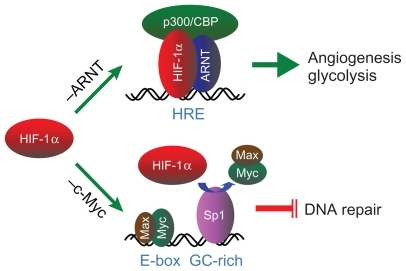Figures & data
Figure 1 A schematic representation of the HIF-1α–ARNT pathway and the HIF-1α–c-Myc pathway. Stabilized HIF-1α participates in the canonical HIF-1α– ARNT pathway (–ARNT) through dimerization with its binding partner ARNT, recruitment of the transcription coactivator p300/CBP, and binding to the HRE in the promoter of the angiogenic and glycolytic genes for transcriptional activation. Alternatively, the HIF-1α–c-Myc pathway (–c-Myc) involves HIF-1α competing with c-Myc for binding to the transcription factor Sp1 in the promoter of DNA repair genes, resulting in selective c-Myc displacement and gene repression.
Abbreviations: HIF, hypoxia-inducible factor; ARNT, aryl hydrocarbon receptor nuclear translocator; HRE, hypoxia-responsive element.

Figure 2 A hypothetic model illustrates that malignant progression results from antiangiogenic therapy. Angiogenic inhibition deprives tumor cells of oxygen and nutrients, resulting in vessel regression and thereby death of the majority of the tumor cells. However, hypoxic cells harbored within the solid tumor are able to tolerate severe hypoxia by undergoing genetic alterations for malignant progression via the HIF-1α–c-Myc pathway and by inducing angiogenesis and glycolysis for cell proliferation via the HIF-1α–ARNT pathway.
Abbreviations: HIF, hypoxia-inducible factor; ARNT, aryl hydrocarbon receptor nuclear translocator.
